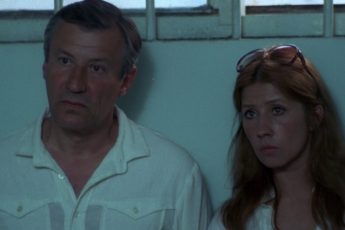Expedition Cinema
Wladimir Schnejderow’s The Golden Lake (Zolotoje Osero, 1935)
Vol. 14 (February 2012) by Patricia Bass
In the words of Alexander Schwarz, co-curator of the Berlinale’s Retrospective, Soviet director Wladimir Schnejderow did “dangerous film work.” He filmed the historic maiden airplane flight from Moscow to Tokyo (despite the fact that his camera crew refused to accompany him on board), and his reputation led him to be hired as “expedition filmmaker” for the Soviet studio Mezhrabpom.
The Golden Lake is a key example of a very unique Soviet genre, the expedition film. Set in the remote Altai mountain range where Russia, Mongolia, China and Kazakstan meet, the film’s “raison d’être” seems to be it’s geographic exoticism. The plot is rote – we have an adventure, we have a girl, we have devotion to the Soviet Union, and we have the antagonists easily identified by their lack of cleanliness and greedy individualism. However, due to exquisite camera-work documenting the setting – a far-away area of Russia where few city-dwellers would ever visit –, the film was considered important enough to be distributed not only throughout Russia, but likewise abroad.
The film opens with oboe music, and in front of the background of the Altai mountains each actor poses portrait-style, either individually or with another, as their character’s name appears beneath them. Could the fictional characters possibly be acknowledging the existence of the camera? Or the fact that they are subject to the anonymous gaze of the public? Most likely not. The self-conscious staging only appears for the introduction of the characters, but indicates a running super-narration that hyper-fictionalizes the film for its entire duration.
Take the opening scene. A voice-of-god narrator informs us that “some shady characters are hunting for gold”. Indeed, we see several severely dirt-stained men (perhaps a more implicit reiteration of their shadiness) mucking around in a river looking for gold. As if the images and narration did not fully establish the dubious nature of these individuals, the background music changes with the scene, becoming reminiscent of the wolf’s theme in Peter and the Wolf. The gold-hunters quickly come to the conclusion that a hermit living in the area, who they refer to as the Shaman, is hiding gold from them, and they set off to confront him (violently, that is).
Thus begins a story that pits a variety of groups against each other: scientists who were sent from the Soviet Union to search for mineral resources, a dashing young geologist looking to join them with his beautiful Soviet guide, an indigenous tribe who takes the wayward travelers in, and the group of greedy gold-diggers. The young geologist, attractive and friendly, is obviously our hero, and his brave young Soviet guide our heroine. In the space of two hours, they experience a kidnapping, a forest fire, and the discovery of gold.
But what is most striking about this adventure story is what happens beyond the confines of the plot. Director Schnejderow sprinkles the film with breath-taking shots of the Altai mountain region, and his close-up shots, surprisingly ahead of their time, permit the viewer to see a baby bear climb a tree, or Russian flamingos and a fox at rest. Even during several scenes of a large-scale forest fire the camera hovers on the beauty of a tree ablaze, the grass swiftly catching the flames lovingly. The focus of the image shifts back and forth, and the light that appears between the branches of a burning tree becomes an aesthetic treasure captured through the lens of the camera.
The film has other worthwhile aspects: the Soviet-brand feminism, for example, that reveals itself in Marinka, the strong female guide who gladly climbs down muddy crevasses and saves her companion from near-death at the hands of the bandits. The film also unveils a period-specific interest for the radio and the phonograph. The focus of the camera on these apparati – be it during a radio message from the geologists to their Soviet base camp, or a phonograph recording of Soviet pop music playing over a view of the Golden Lake – reminds the audience of the historic specificity of these devices and of the importance of music, not only in social life, but in the transmission of Soviet propaganda.
But also, and above all, the music complements the images of the Altai region which is the clear subject of the film. Like the filming of the wildlife, the recorded music allows something that is at once natural, technically-mediated, and universal, and yet so very Soviet and geographically-specific. In this film, it’s not Marinka who is the most memorable, nor the “shady characters”, or even the helicopters who bomb the forest fire with giant balloons full of water, but a low-quality recording of a Soviet pop song playing over a very still lake in the Altai mountains of the Soviet Union…




Leave a Comment